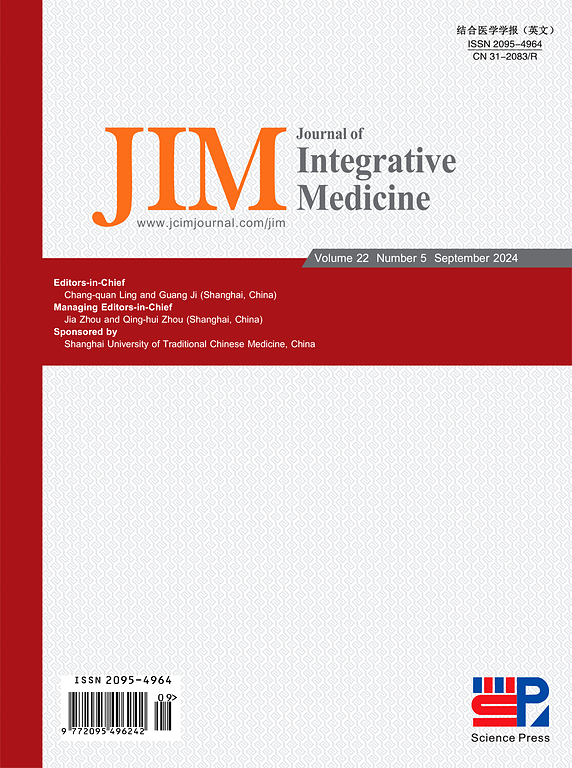Integrated-omics analysis defines subtypes of hepatocellular carcinoma based on circadian rhythm
IF 4
2区 医学
Q1 INTEGRATIVE & COMPLEMENTARY MEDICINE
引用次数: 0
Abstract
Objective
Circadian rhythm disruption (CRD) is a risk factor that correlates with poor prognosis across multiple tumor types, including hepatocellular carcinoma (HCC). However, its mechanism remains unclear. This study aimed to define HCC subtypes based on CRD and explore their individual heterogeneity.
Methods
To quantify CRD, the HCC CRD score (HCCcrds) was developed. Using machine learning algorithms, we identified CRD module genes and defined CRD-related HCC subtypes in The Cancer Genome Atlas liver HCC cohort (n = 369), and the robustness of this method was validated. Furthermore, we used bioinformatics tools to investigate the cellular heterogeneity across these CRD subtypes.
Results
We defined three distinct HCC subtypes that exhibit significant heterogeneity in prognosis. The CRD-related subtype with high HCCcrds was significantly correlated with worse prognosis, higher pathological grade, and advanced clinical stages, while the CRD-related subtype with low HCCcrds had better clinical outcomes. We also identified novel biomarkers for each subtype, such as nicotinamide n-methyltransferase and myristoylated alanine-rich protein kinase C substrate-like 1.
Conclusion
We classify the HCC patients into three distinct groups based on circadian rhythm and identify their specific biomarkers. Within these groups greater HCCcrds was associated with worse prognosis. This approach has the potential to improve prediction of an individual’s prognosis, guide precision treatments, and assist clinical decision making for HCC patients.
Please cite this article as: Li XJ, Chang L, Mi Y, Zhang G, Zhu SS, Zhang YX, et al. Integrated-omics analysis defines subtypes of hepatocellular carcinoma based on circadian rhythm. J Integr Med. 2025; 23(4): 445–456.
综合组学分析根据昼夜节律定义肝细胞癌的亚型。
目的:昼夜节律紊乱(CRD)是多种肿瘤类型中与预后不良相关的危险因素,包括肝细胞癌(HCC)。然而,其机制尚不清楚。本研究旨在基于CRD定义HCC亚型,并探讨其个体异质性。方法:采用HCC CRD评分法(HCCcrds)量化CRD。使用机器学习算法,我们在The Cancer Genome Atlas liver HCC队列(n = 369)中鉴定了CRD模块基因并定义了CRD相关的HCC亚型,并验证了该方法的稳健性。此外,我们使用生物信息学工具来研究这些CRD亚型的细胞异质性。结果:我们定义了三种不同的HCC亚型,它们在预后方面表现出显著的异质性。高HCCcrds的crd相关亚型与预后差、病理分级高、临床分期进展显著相关,而低HCCcrds的crd相关亚型具有较好的临床预后。我们还为每个亚型确定了新的生物标志物,如烟酰胺n-甲基转移酶和肉豆浆酰化富丙氨酸蛋白激酶C底物样1。结论:我们根据肝细胞癌患者的昼夜节律将其分为三组,并确定了他们的特异性生物标志物。在这些组中,HCCcrds越大,预后越差。这种方法有可能改善个体预后的预测,指导精确治疗,并协助HCC患者的临床决策。本文请注明:李晓军,常丽,米莹,张刚,朱世生,张永祥,等。综合组学分析根据昼夜节律定义肝细胞癌的亚型。集成医学[J];打印前Epub。
本文章由计算机程序翻译,如有差异,请以英文原文为准。
求助全文
约1分钟内获得全文
求助全文
来源期刊

Journal of Integrative Medicine-Jim
Medicine-Complementary and Alternative Medicine
CiteScore
9.20
自引率
4.20%
发文量
3319
期刊介绍:
The predecessor of JIM is the Journal of Chinese Integrative Medicine (Zhong Xi Yi Jie He Xue Bao). With this new, English-language publication, we are committed to make JIM an international platform for publishing high-quality papers on complementary and alternative medicine (CAM) and an open forum in which the different professions and international scholarly communities can exchange views, share research and their clinical experience, discuss CAM education, and confer about issues and problems in our various disciplines and in CAM as a whole in order to promote integrative medicine.
JIM is indexed/abstracted in: MEDLINE/PubMed, ScienceDirect, Emerging Sources Citation Index (ESCI), Scopus, Embase, Chemical Abstracts (CA), CAB Abstracts, EBSCO, WPRIM, JST China, Chinese Science Citation Database (CSCD), and China National Knowledge Infrastructure (CNKI).
JIM Editorial Office uses ThomsonReuters ScholarOne Manuscripts as submitting and review system (submission link: http://mc03.manuscriptcentral.com/jcim-en).
JIM is published bimonthly. Manuscripts submitted to JIM should be written in English. Article types include but are not limited to randomized controlled and pragmatic trials, translational and patient-centered effectiveness outcome studies, case series and reports, clinical trial protocols, preclinical and basic science studies, systematic reviews and meta-analyses, papers on methodology and CAM history or education, conference proceedings, editorials, commentaries, short communications, book reviews, and letters to the editor.
Our purpose is to publish a prestigious international journal for studies in integrative medicine. To achieve this aim, we seek to publish high-quality papers on any aspects of integrative medicine, such as acupuncture and traditional Chinese medicine, Ayurveda medicine, herbal medicine, homeopathy, nutrition, chiropractic, mind-body medicine, taichi, qigong, meditation, and any other modalities of CAM; our commitment to international scope ensures that research and progress from all regions of the world are widely covered. These ensure that articles published in JIM have the maximum exposure to the international scholarly community.
JIM can help its authors let their papers reach the widest possible range of readers, and let all those who share an interest in their research field be concerned with their study.
 求助内容:
求助内容: 应助结果提醒方式:
应助结果提醒方式:


